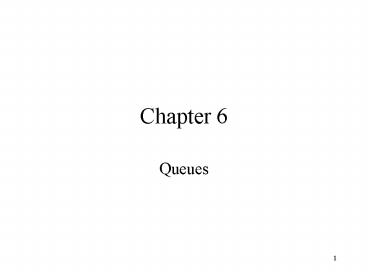Queues - PowerPoint PPT Presentation
Title:
Queues
Description:
Chapter 6 Queues – PowerPoint PPT presentation
Number of Views:67
Avg rating:3.0/5.0
Title: Queues
1
Chapter 6
- Queues
2
Topics
- FIFO (first0in-first0out) structure
- Implementations formula-based and linked classes
- Applications
- railroad-switching problem
- shortest path for a wire that is to connect two
points - pixels labeling
- machine shop simulation
3
Queues
4
Abstract data type
5
Queues 1
- location(i) i - 1
- add - O(1)
- delete - T(n) (need to slide items to front)
6
Queues 2
- location(i) location(1) i - 1
- add - worst-case T(n) (when buffer is full)
- delete - O(1)
7
Shifting when rearMaxSize-1 and front gt 0
8
Queues 3
- location(i) (location(1) i - 1) MaxSize
- add - T(1)
- delete - T(1)
9
Empty and full queue
- Empty queue frontrear
- full queue can only hold up to MaxSize-1 elements
10
Formula-based class Queue
11
Constructor - T(1) when T is internal
O(MaxStackSize) when T is user-definedFirst -
T(1)
12
Last - T(1)
13
Add and Delete - T(1)
14
Linked presentation
15
Addition
16
Deletion
17
Class definition
18
Destructor - T(n)
19
IsFull - T(1)
20
First and Last - T(1)
21
Add - T(1)
22
Delete - T(1)
23
Wire-Routing Problem
- Need to route wires from A to B using the
shortest-path. - Routing region can be represented with a grid an
nxm matrix of squares - wire runs midpoint of one square to midpoint of
another making only right-angles. - Grid squares that already have wires in them are
blocked.
24
Wire-Routing Problem
25
Wire-Routing Problem
- Begin at source a
- label its reachable neighbors with 1
- next the reachable neighbors of distance 1
squares are labeled 2. - Continue labeling processing until either reach
destination b or have no more reachable
neighbors. - If b is reached, label it with its distance.
26
Wire-Routing Problem
- To construct shortest path,
- Start from b and move to anyone of its neighbors
labeled 1 less than b's label. - From the neighbor found in previous step, move to
one of its neighbors whose label is 1 less - repeat until square a is reached
- The sequence of neighbors collected forms the
shortest path.
27
Wire-Routing Problem
28
(No Transcript)
29
(No Transcript)
30
Railroad Car Rearrangement
31
Rules
- Reserve Hk for moving cars directly from the
input track to the output track - Move car c to a holding track that contains only
cars with a smaller label if there are several
such tracks, select one with largest label at its
left end otherwise, select an empty track (if
one remains)
32
Output
33
Hold
34
Hold (continue)
35
Hold (continue)
36
Output without using queue
37
Output without using queue (continue)
38
Output without using queue (continue)
39
Railroad without using queue - O(nlogk)
40
Railroad without using queue (continue)
41
Railroad without using queue (continue)
42
Image-Component labeling
43
Offset
44
Wall of blank pixels (0)Note change 1 to 0
45
Component labeling
46
Component labeling (continue)
47
Evaluation
- Initialize the wall - T(m)
- Initialize offsets - T(1)
- identifying and labeling pixels of one component
- T( of pixels in component) - identifying and labeling nonseed component - T(
of pixels in component pixels in image) O(m2) - Overall complexity - O(m2)
48
End of Chapter 6































